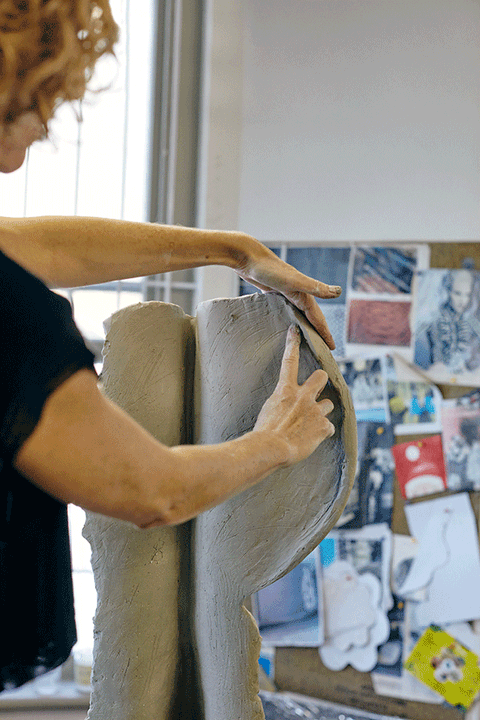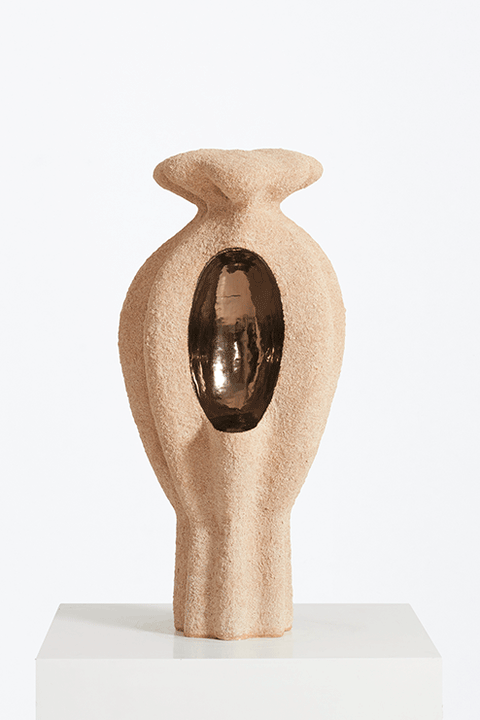My Enquiry (0)
No artwork has been selected.
Please choose an artwork to enquire.
Enquiry Submitted
Thank you for your enquiry and interest in our artists’ work. A member of the gallery team will respond shortly.
000%

Martine Jackson on the hidden lives of vessels
1 Dec 2022 (5 min) read
There is a definite awareness of feminine and maternal energy while I create. My works are heavily inspired by the marvels of creation found in the natural world as well as the curves and undulations of a woman’s body.
Martine Jackson’s sculptural ceramic works draw from the sublime structures found in the natural world. With a deep reverence for the lively materiality of the medium, Jackson’s textural forms hold a fluid sensuality. In the first of a new series of artist interviews, Southern Guild sits down with the Cape Town-based ceramic artist to discuss her current creative approach and the steadfast significance of art-making in an increasingly virtual world.
Each of your large-scale sculptural works is built through the hand-coiling method. Can you give some insight into the challenges and joys of working with such a labour-intensive creative process?
Hand-coiling is an incredibly demanding process. It’s like 3D printing with clay. If you’re impatient and layer too quickly, the clay will sag and lose its form. You have to wait for the clay to harden slightly and add more weight to the structure. And then you sculpt in between these accumulative layers. The process is laborious, very intentional and meditatively slow.
Once the making is complete, there’s still so much that can go awry. Clay is like a live material. It shifts, dries out and absorbs moisture before a firing. People don’t realise the nerves needed to be a ceramic artist! But when you have spent hours upon hours obsessively blending and moulding and texturing a work, and it survives the elements of 1200 degrees and comes out of the kiln even more beautiful than you imagined – that’s a joy like no other.
Can you tell us more about your introduction to the medium?
I grew up around clay and art-making. My late mother established the Barbara Jackson School of Ceramics before I was born. The school offered children’s pottery classes that were initially held in my childhood home. My early years were spent in and out of the classroom with my mom and a throng of other local kids. It was very much the ‘in’ spot to send your kids for classes if you lived in Cape Town.
When my parents got divorced, the classes were then held in my mom’s studio in Green Point. On the weekends, when I used to stay with my mom and her late partner, Carrol Boyes, they would both be working on their sculptures and I would be creating beside them. I naturally gravitated toward such a familiar and expressive material.

Detour, Earthenware, enamel, 2023

Detour, Earthenware, enamel, 2023
In light of your mother’s profound artistic influence, how did you go on to actively cultivate your own creative voice and aesthetic?
I have always had an awareness of my mother’s mastery. I’ve also always been conscious of forging and following my own authentic path and aesthetic. The world that shaped the formative years of my early adulthood was very different to the one that her work grew from. My conceptual concerns, my sensitivities and influences are my own.
There seems to have been a distinct evolution in your practice towards a deeper exploration of form. Can you share more about what motivated this transition?
This progression came from a growing fascination I had with exposing the inside of a vessel. I began thinking about making visible all the wonderful rhythmic curves that are hidden in a vessel’s closed form. It was a poignant and emotional moment in my practice; I was giving myself permission to express vulnerability. I wanted to explore this openness both within myself and my sculpting process. I began to create open vessels in 2018 and have continued to deepen and develop this approach.
Your works are not explicitly erotic but hold an innate sensuality and feminine presence. How much of this is intentional?
There is a definite awareness of feminine and maternal energy while I create. My works are heavily inspired by the marvels of creation found in the natural world as well as the curves and undulations of a woman’s body. My making is also informed by the profound experience of being a woman, wife and mother. From this femininity flows the experience of love-making and the power of creation and all the abundant artistry that comes with being a woman.

Jackson in her studio in Cape Town

The Siren, Glazed stoneware, 2021
Your use of colour feels restrained and intentional. How would you describe your relationship with colour?
I’ve always been mindful of how colour can accentuate or detract from form. I guess this approach is reflective of my own way of being; I’m often restrained but I enjoy being bold. Right now, that boldness is manifesting solely in form. Again, nature is my grounding tool and it feels right that earthy tones have found their home on my surfaces. Having said that, I travelled to India in February this year and was deeply stirred by the explosion of colour. The wild colour of that country felt like a celebration of life. I felt exhilarated, so who knows… maybe some colour will sneak itself in somewhere soon.
In an increasingly digital and tech-centric world, what do you believe is the role of art-making in society?Can you tell us more about your introduction to the medium?
I believe it’s still so important to create with one’s hands. Hands can articulate creativity like no computer or machine can. Hands facilitate human connection. I believe this sense of connection is imperative for a healthy society.
Art is a medium to express one’s emotional, cultural, social and political ideas. No matter how much we progress technologically, people will still respond emotionally to art. Being awed and inspired by form, or paint on canvas, or the creativity of another person – that will always be a soul-nourishing human experience.

